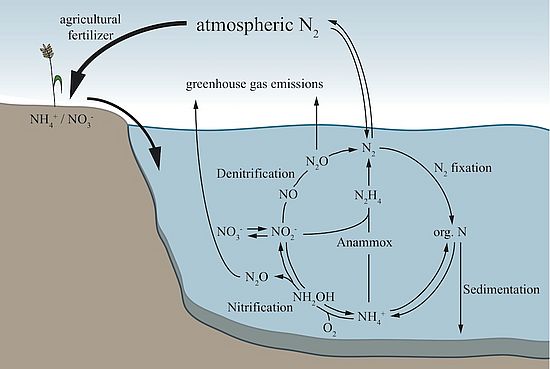NOx transformation processes in lakes and the ocean and associated isotope effects
Bioavailable nitrogen (e.g., NOx) is an important driver of lacustrine eutrophication and modulator of ocean fertility. Consumption and production of nitrogenous compounds is controlled mainly by biological processes. Our research focuses on “fixed N eliminating” processes in aquatic redox transition zones, including both organotrophic and chemolithotrophic denitrification, as well as anammox. In particular the “non-traditional” denitrification processes with links to other element cycles (eg. S, Fe) are of great interest to us, not only in terms of microbial community dynamics and relevance for global or local N budgets, but also with regards to their isotopic fingerprints.
Active N cycling is likely to impart a wide range of isotopic signatures. Hence, N-stable isotope ratios in various N species and, more recently, the 18O/16O of nitrate (NO3-) and nitrite (NO2-) are instrumental as indicators of N-cycle processes and fluxes. The dual isotopes also allow the identification of external NO3- inputs in estuaries and lakes. In order to use nitrate N and O isotopes as biogeochemical tracers, it is imperative to know the characteristic isotope effects (isotope fingerprints) associated with specific N transformations, considering both biochemical and physical aspects. Our goal is to expand the still limited data sets of fixed N (NO3-, NO2-, as well as dissolved organic nitrogen and ammonia) isotope ratios in freshwater and marine systems, and from incubation experiments, with the goal to elucidate the controls on the isotopic fractionation of key N transformations at different spatial scales (organism- versus community-level fractionation).


Quick Links
Social Media
